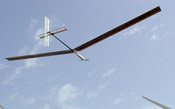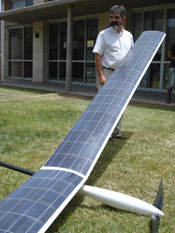Solar Plane Project
Feasibility study and prototype of a solar airplane



Financed by
Coordinated by
Institute of Technology and Renewable Energies of Tenerife (ITER)
Co-workers
Aeronautical Engineering School of the Polytechnic University of Madrid (Escuela Técnica Superior de Ingenieros Aeronáuticos de la Universidad Politécnica de Madrid. UCM Aeronautics E.T.S.I.)
ITER has started the feasibility study for the construction of a solar airplane with the development of the first prototype, whose final aim is the construction of a complete autonomous airplane, non-pollutant and with applications in the fields of observation and monitoring of the Earth.
Among the main challenges that can be found when carrying out this project, are the aerodynamic design, the power generation system based solely on the use of photovoltaic solar cells and the energy storage system, as well as the navigation and tracking systems that include the information transference to the base or bases on land. The construction of a demonstrative prototype has started to better understand all these aspects related to the manufacturing, durability of equipment, etc., going parallel to the general feasibility study. These characteristics are shown in Table 1.
The energy generation system of the prototype, which is currently being built, consists of mono-crystalline silicon photovoltaic cells exclusively, whose efficiency is 18.3% and the 80 cells that have been laminated directly into the wing which can provide about 500W of power when reaching the maximum height of flight. It also has an autonomous navigation system able to maintain a predefined path and to take the most appropriate strategies of flight, depending on the solar radiation environmental conditions.
The autopilot has been implemented with sensors for temperature, pressure and infrared, GPS and an inertial measurement unit that includes accelerometers and gyroscopes. This autopilot also provides information about the voltage and intensity of the cells and includes a via radio telemetry connection, to make the flight parameters possible to track, and their reprogramming if necessary, from a ground station.
The prototype which is being developed is 6.3 meters wide, its fuselage is made out of epoxy resin and Kevlar fibre, and both the wing and tail are of carbon fibre with a wooden and Styrofoam structure.
The first flights of the prototype will be used to incorporate modifications until the airplanes design is validated and can achieve a flying permanence record which will mean a solar plane adapted to its future applications has been built. Nevertheless, the parameters handled during the feasibility study will logically correspond to technologies expected to be available from 2010.
The resulting solar plane of the Feasibility Study is expected to be larger, with a 20 meter wingspan, its characteristics are listed in Table 2. Its bigger dimensions, along with the use of solar cells with higher yields (since 2007, Spectrolab, commercializes cells with an efficiency of 30% and expects to reach 33% efficiency during this year; the Fraunhofer Institute for Solar Energy Systems ISE has achieved efficiencies in concentration technologies of 41,1%), which will enable more electric power from solar radiation. Under these conditions, and spread throughout day and night, the power available is more than 1.5 kW, depending on the latitude and time of year. Half of that power is invested in operating the engines that keeps the airplane moving, therefore, the power used by the payload is high enough so that the airplane to allow many practical applications. The energy required for night-time operation is stored in a lithium-sulphur battery technology, and proven successful in the British solar plane Zephyr-6, these batteries can produce energy densities well above those that give the lithium-polymer batteries.
The configuration chosen seeks to maintain an aerodynamic drag, the force that the motors have to overcome, exceptionally low. The aircraft has two wings, a main one, and another one for support, the main wing is larger is located behind the secondary one, the canard which is smaller. The bond between the main wing and the canard is reduced to the minimum in order to reduce weight and aerodynamic drag. This choice requires unconventional solutions to control the device and the location of the load. Equipment loaded on the aircraft, such as batteries, the autopilot system and radio communication, are housed inside the main wing and canard. It also provides the possibility to place some equipment such as cameras in the inside of fuselage bodies held to the wing. These solutions depend on the specific tasks the airplane will carry out, as mentioned, most applications are still undiscovered. With regard to the structure that shapes the plane and homes the load is made of a composite coating with foam. This achieves a very light weighted and durable structure. The propulsive system consists of five propellers driven by brushless DC motors for high performance.
| TABLA 1 | FICHA TÉCNICA PROTOTIPO 9.10 |
|---|---|
| AERODYNAMICS | |
| Wingspan | 6,3 m |
| Weight | 3,5 kg |
| Wings load | Aprox. 1,5 kg/m2 |
| Maximum speed | 60 m/s |
| PROPULSION | |
| Motor | Motor brushless de alta eficiencia de 400W |
| Propeller | Fibra de carbono hueca 1,3 m de diámetro alta eficiencia |
| MATERIALS AND STRUCTURE | |
| Components | Composites carbono /kevlar/epoxi |
| ENERGY MANAGEMENT | |
| Batteries | Polímero de litio |
| SOLAR PANELS | |
| Power | 332 W (see level) — 500 W (maximum height) |
| Efficiency | 18,3% (see level) — 23.8% (maximum height) |
| Solar cells | Mono-crystalline silicon |
| Dimension | 156x156 mm |
| Thickness | 200 microns |
| TABLA 2 | FICHA TÉCNICA ESTUDIO DE VIABILIDAD |
|---|---|
| AERODYNAMICS | |
| Wingspan | 20 m |
| Weight | Approximately 180 kg |
| Wings load | Approximately 10 kg/m² |
| Maximum speed | 40 m/s |
| PROPULSION | |
| Motor | 5 High efficient Motor brushless |
| Propeller | High efficiency hollow Carbon fibre |
| MATERIALS AND STRUCTURE | |
| Components | Composites carbono /kevlar/epoxi/espuma |
| ENERGY MANAGEMENT | |
| Batteries | Lithium polymer |
| Solar cells | Arseniuro de galio |
| Dimensions | Hasta 60 cm2 de superficie |
| Efficiency | Aprox. 33% |
| Weight | 84 mg/ cm² |